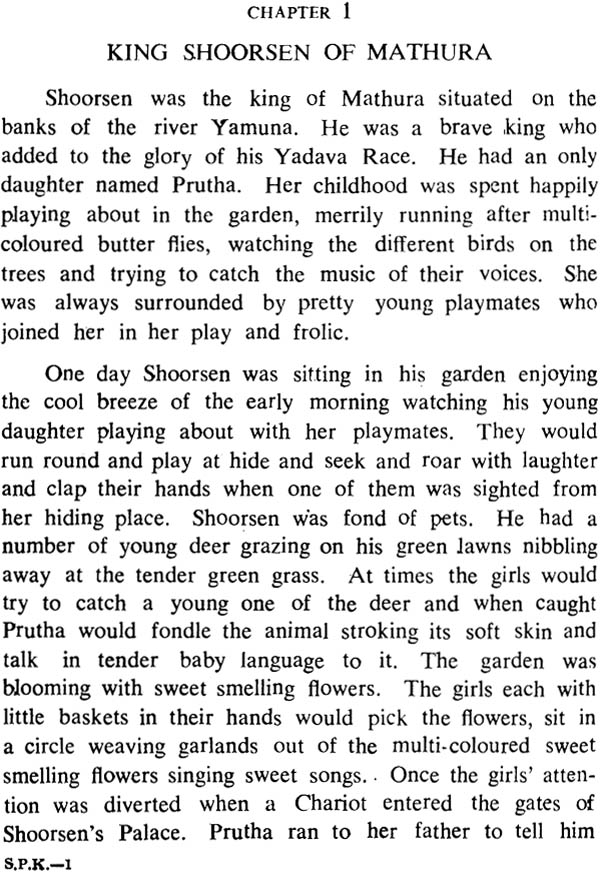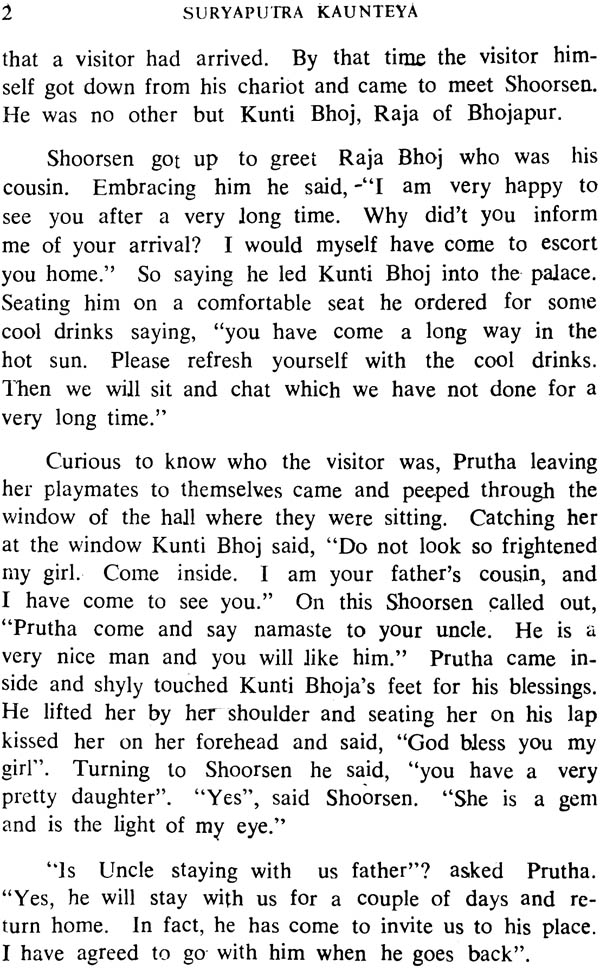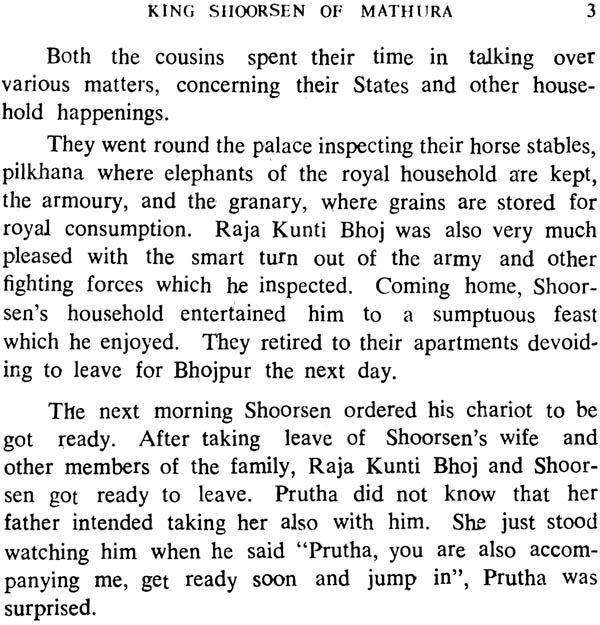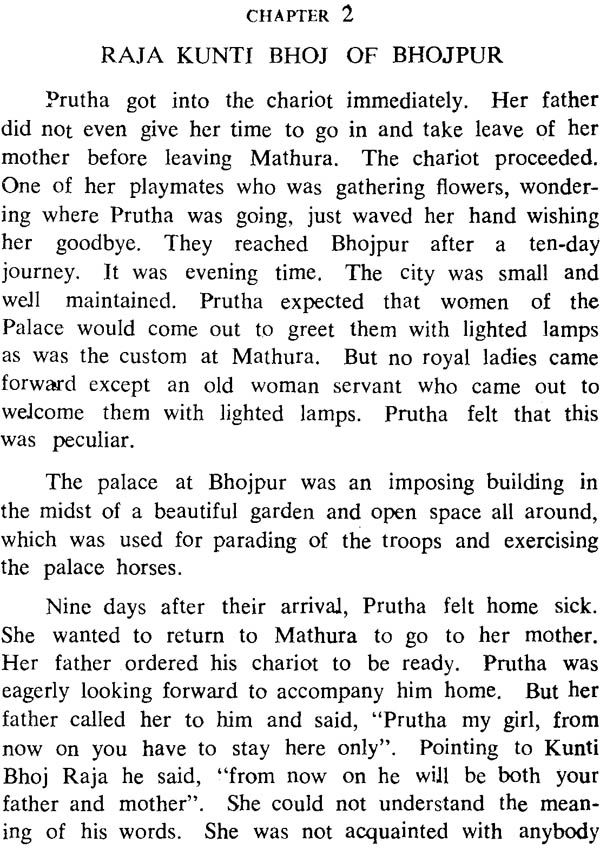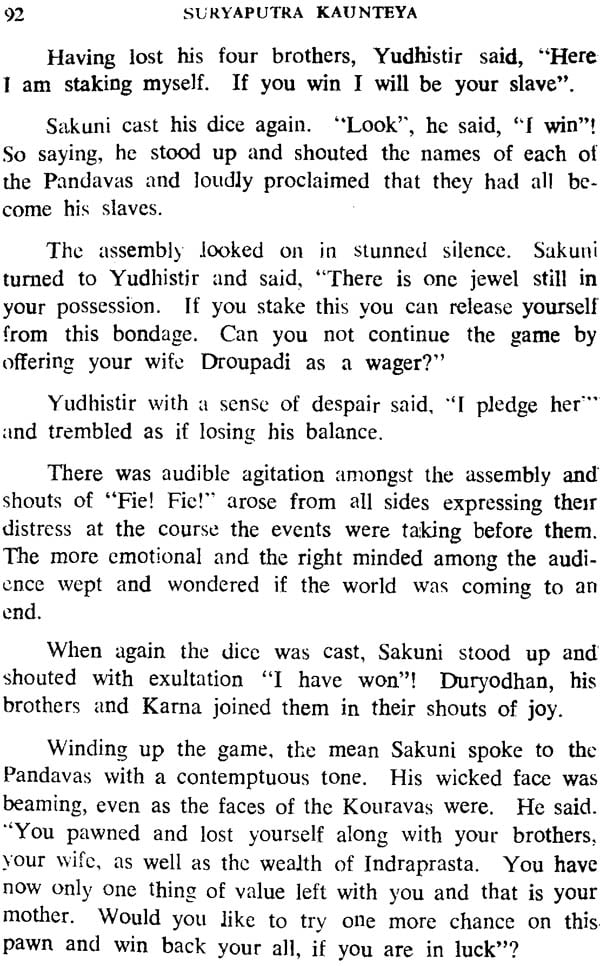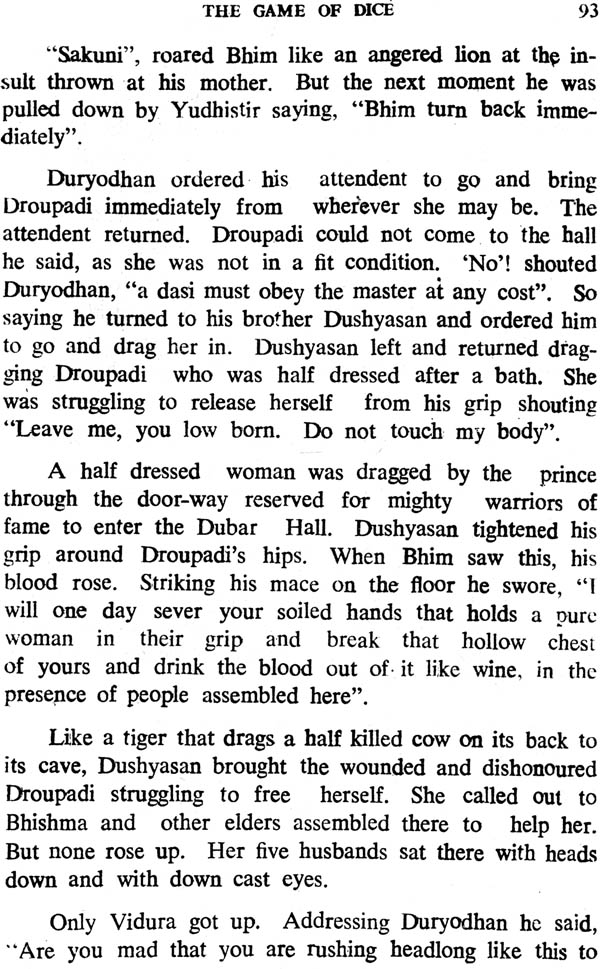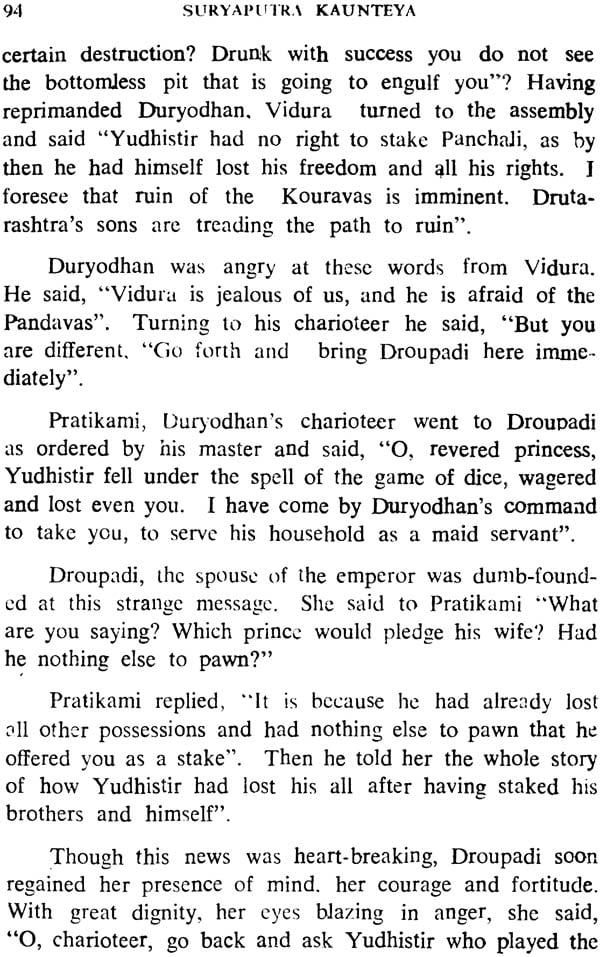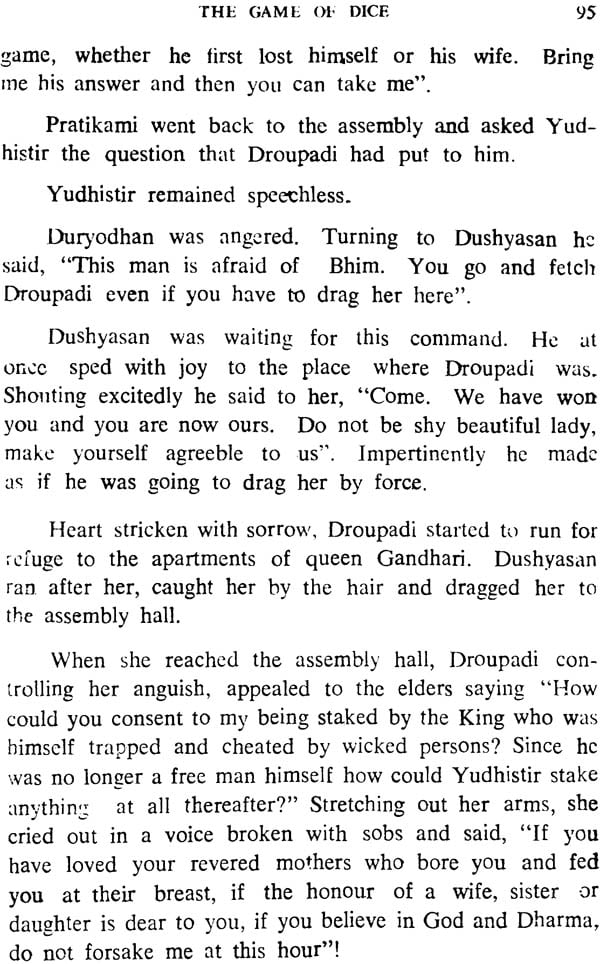
Suryaputra Kaunteya (The Story of Karna The Great)
Book Specification
| Item Code: | IHL714 |
| Author: | Indirabai M. Rau |
| Publisher: | Bharatiya Vidya Bhavan |
| Edition: | 2002 |
| ISBN: | 8172762909 |
| Pages: | 175 |
| Cover: | Paperback |
| Other Details | 7.2 inch X 4.8 inch |
| Weight | 160 gm |
Book Description
Few Indian women in their eighties have ventured to become writers in the English language of books intended for their children or grandchildren as Shrimati Indirabai M. Rau, the author of this booklet.
Born in 1901, married at ten and becoming a mother at fifteen, Indirabai saw much of the world and its childhood. She went to a south Indian government—aided school, presided over by an English woman, who was its head-mistress, learnt to recite the poems of Henry Wordsworth Longfellow, Rudyard Kipling and William Cooper. At home, before she left for her young husband’s residence, her mother taught her some of the unforgettable Tamil and Canarese and Marathi folk songs.
After a long stay in Madras with her husband, she moved to New Delhi after his death and continued her days with her son watching the two grandsons grow up and entertaining them with stories of Hindu folklore. So she dipped into the almost inexhaustible stories in the great Mahabharata, much to the delight of her grandchildren and other young listeners who used to cluster round her.
One such small book containing a collection of such stories, entitled Easy Stories from the Mahabharata has been published by the India Book House Education Trust of Bombay. This book being offered to young readers in India and abroad contains the story of Karna, one of the great warriors of the Mahabharata.
Smt. Indirabai M. Rau passed away in 1985 at the age of 84.
Born in 1901, in her mother’s ancestral home at Lieimandai Estate House in the district town of Tirunelveli in South India of a distinguished Maharashtrian family, married to a man. eleven years older to her in 1912, to Mr. R. Madhava Rau, a distinguished physicist having his own workshop and laboratory, _a daughter born to her in 1916 followed by a son in 1922 and widowed in 1961, my one time school friend and a dear personal friend in later years and up to now, Balu Bai alias Shrimati Indirabai M. Rau, as she came to be known later, found herself at a loose end after 1961 when her husband died of a massive heart attack while traveling in a city transport bus in the city of Madras. So in 1965 she pulled out of her roots at Madras to settle down permanently with her son in New Delhi. By then both her children were well settled in life, her daughter as the wife of a Brigadier in the Indian Army and the son as a Senior Executive in the Indian Navy. So, with her two affectionate children sparing no pains to make the rest of her life comfortable and easy, she had nothing to complain about.
But somewhere deep down in her, a desire persisted. She remembered the tales and stories of long ago, told to her by her mother, herself a self made woman Mrs. Kamala bai L. Rau, who ruled her personal zamindari estate in Tirunelveli, district for half a century and was herself steeped in Hindu folklore and legends. She remembered her early married years spent helping her mother with the National Girls’ School, sponsored by Dr. Annie Besant in the Home Rule days. She remembered helping in social work organizations run by the pioneering women of those days like Mrs. Cousins, Dr. Muthulaxmi Reddy, Mrs. Kamalabai, L. Rau, Sister Subbulaxmi Ammal and others under the auspices of the Woman’s Indian Association.
She remembered working in the Seva Sadan started in Madras by Mr. Deodhar of the Servants of, India Society and Mrs. Janakibai Bhat of the Seva Sadan Society of Poona with the help of Lady Venkatasubba Rau. She remembered the days of the national struggle and Gandhian movement of constructive work programmes undertaken by the Women’s Swadeshi League, the Desh Sevika Sangh, the Charkha Sangh in close association with women like Smts. Janamal Ambujammal, Ammtu Swaminadhan, Krishnabai Nimbkar, Sakhoobai, Manjubhashini, Rukmini Laxmipati and others. All these things she related to her two grandsons who listened avidly and worried her for more and more stories, true and mythical. Having all the time on her hands she began to consider why she should not write down the stories she told her own grand children, for the grand children of India as a whole. Thus was born her desire to write.
Indirabai’s formal education was limited to the then Fourth Form of High Schoolor to the Eighth Standard of today. She studied in the Presidency Training School in Egmore, Madras. In that school, they taught her to write good English and to speak good English as well. Married as she was at the age of twelve, the sum total of those educative years was small, indeed. But Indirabai made up for this in a large measure by her own effort at self education. Her husband subscribed for books like The Scientific American, The Sphere, Geographic Magazine, Modern Review, the Indian Review, The Harijan and Young India. He even gave her books by Marie Stopes and Margaret Sanger on Birth Control. Thus she developed the habit of a good reader of good books, both in English and the other languages, such as Marathi her mother tongue, Sanskrit her second language in School and Tamil, the language of local intercourse and of the countryside in which she was brought up. Perhaps other Indian women too could boast of such self education in those times, but in this she was in the good company of pioneers of that age.
Indirabai’s first attempt at writing short stories in English, was a collection of tales and stories culled from the Indian epics of The Mahabharata and the Ramayana. In the year 1971, the India Book House people published her "Easy Stories from The Mahabharata" which has now gone into its fourth edition. The present little book, "Suryaputra Kaunteya {The Story of Kama, the Great)" is a good successor to this one, intended for children of a higher age group. I have no doubt that it will be a success. Besides these two books, Indirabai has got ready for publication, other true stories like; "Kattabomman,” Life of Purnayya of Mysore,"' "My Mother’s Memoires Translated," "When Emden Bombarded Mad1‘as," "Kunta Kinte, the African Boy," among others waiting to be edited.
I have great pleasure in introducing my erstwhile school- mate and co-worker and budding author of eighty years of age to the English reading children of today. This growing generation cut off as it is from a hoary, past I am sure will derive great inspiration reading such books as Indirabai has to offer to them.
When my grandchildren were young, there were after me for bed time stories. My stock of such stories was of Cindrella, Sleeping Beauty, Snow drop and the Seven Dwarfs, Jack and the Bean stalk and several such which I had read in my own early school days. The stock soon exhausted. I was at first at a lost to think of new stories to tell. Fortunately, I found a copy of Rajaji’s Mahabharata among the old books in the family book case, stacked away as unwanted. I read through it with great fascination. I soon felt that I could confidently now re- late Indian bed time stories to my grandsons, which they could easily understand. But soon my grandsons grew up and their interest in such stories began to fade. But on the other hand, my own interest in such stories began to grow. So, finding time hanging heavy in my hands, I felt I could turn to a creative hobby of writing them down for other children to read when they grew up to the reading age. This is how I developed my habit of writing short stories of Indian literature in the English language.
English has become the coveted language of the children of the elite. Indian culture, to which they are fast becoming strangers, needs to be conveyed in communicable form. A good number of short stories I attempted to write soon got collected with me. I sent some of these amateur attempts for publication to the India Book House. I felt thankful to them when they accepted and published some of them in a small book entitled "Easy Stories from Mahabharata." I am glad to say that this has gone into four editions, The encouragement I received by the above publication made me try to write stories for other children. As I read the epics and other books of historical interest as well as Sunday feature articles in journals and newspapers, I was impressed with the lives and characters of many personalities described therein. I became specially interested in the life of Karna in the Mahabharata. This led me to read other versions of Karna’s life in Tamil, Marathi and English. .Thus, I read Rajaji’s Tamil Book, “Vyasar Virundu," Rajaji’s English "Mahabharata" and Shivaji Sawant’s, Marathi book "Mrityunjaya." All these helped me to gather much information on the varied aspects of Karna’s life. This enabled me to present the life of Kama, who though born under strange circumstances, was able to emerge out of it all as a brave man and a hero, whom growing children could look up to and emulate. The young are faced today with a grave struggle ahead for survival. If I have succeeded in conveying my message to them even in a small way, I shall feel that my efforts have been rewarded.
My thanks are due to my typist Shri PK. Rao, who did a good job of preparing the manuscript for publication. My thanks are due to my sister Dr. Mrs. Krishnabai Nimbkar for encouraging me to apply my self purposefully to write short stories in English and for her help in over- seeing my writings. I thank my brother Capt, RL. Rau for helping to read through the manuscript and for his help in preparing the format of the book. Finally, my sincere thanks are due to my old school mate and friend, Smt, S. Maujubhashini of Madras of Balmandir fame, for introducing me to the public, to whom I am but little known.
Lastly in fond affection, I dedicate this book specially to my great grandsons Shridhar, Aditya and Girish, and my great nephews and grand nieces scattered all over this country and overseas as well as their children.
One can sing the praises of Karna in many tunes. The first is that of a dutiful son. He gladdened the heart of his foster parents, Adhirata and Radhamata. He held Radhamata in high esteem, because she had fostered and loved him, more than his own mother Kunti, who had abandoned him soon after his, birth.
He was an affectionate brother, inseparable from Shan, his younger brother. Shan too always stood by Karna at his side, at all crucial moments in his life, even as Karna stood by Shon.
As an ambitious sishya Or pupil, he proved his abili- ties, in spite of Dronacharya refusing to teach him the art of war, because of his supposed low birth. Karna be- came a master archer, making the Sun God his Guru and practising by torch light in the forests at night. He proved his abilities at a tournament, but they were not recognised because of his supposed low birth as the son of a charioteer.
Karna is befriended by Duryodhan even when he is insulted as a charioteer's son. In return, Karna swears to stand by Duryodhan at the cost of his own life. His refusal to desert Duryodhan, even after knowing that the Pandavas were his own brothers, proves his loyalty and steadfastness in adversity.
Karna is not only a lover of Vrushali, whom he met first at Prayag, but also her loyal husband. She bore him brave sons. It wa" Vrushali's soothing care that healed the wounds Karna received, as a warrior engaged in battle, Blessed with such a wife and sons, his home became a fountain of love and joy.
The warrior blood in him was roused, when he picked up the sceptre thrown by Bhishma in the court hall, in disgust. He took the challenge, went on wars of conquest and returned victorious to Hastinapura to restore the sceptre to its place of due honour.
Karna had no equal as a giver. Even when Indra came to his door as a beggar, he parted with his Kavacha- Kundalas from his body, without a second thought of the risk .it involved for his life. None returned empty handed from his door.
That Karna was a devotee of Shri Krishna, was proved by the fact that there flowed a silent love between the two. When Krishna disclosed to Karna, the secret of his birth, understanding how ignorance of it caused great suffering to Karna, it showed Krishna's love for him. Krishna was the first to address him as "Kaunteya" on Karna's death bed. Karna's parting smile and his last request to Krishna to perform his last rites with his own hands, shows the bonds of love between the two.
Although Karna possesses all the qualities as described above, his life was one of great struggle and disappoint- ment. Yet he faced them with courage and strength, which, only a man who has gone through suffering can understand. Now, after describing the character of Karna, it would not be out of place to dwell on the place of Karna in the Mahabharata and the part he played therein. We have all read the Mahabharata, sometimes to while away our time and sometimes to become better acquainted with the deeds of valeur, bravery, sacrifice, suffering and glory 'of the characters in the epic. Often, we are stirred by the sense of deep patriotism and loyalty shown by some of the characters. Often we are mystified by the manner in which difficult situations are faced and overcome by the charac- ters in the epic. They create in the reader's mind, a sense of reverence of this great epic, which in turn seems to reveal a hidden hand meant to guide man through life's ups and downs. The life of Karna and his final death on the battlefield epitomises the essence of the purpose of the epic Mahabharata.
The Mahabharata, is essentially the story of a great rivalry between two families, the Kauravas and the Pan- davas. The Kauravas had illegally usurped a share of the kingdom that tightly belonged to the Pandavas, causing them much harassment. The Pandava brothers, however, chose to follow the path of righteousness and truth, which made them popular with the people. The Kauravas be- came jealous and envious of such popularity and from this arose all the trouble. Both Kauravas and Pandavas were tutored and trained in the art of Government and in the art of war, by the same Guru - Dronacharya. It was at this time that Karna entered into the lives and exploits of the Kauravas and Pandavas, Karna came to Hastinapur and also sought to study and train under Guru Dronacharya, the tutor of the royal princes. But the Guru refused to take Karna under his care, because, Karna did not belong to the Kshatriya clan, being only a charioteer's son. Dronacharya's refusal hurt Karna to the core. But am- bitious as he was, Karna made the Sun god as his guru. With his blessings, he practised archery by torch light, and became a master archer. He could soon rival Arjun of the Panda vas, the favouriite pupil of Dronacharya. He proved his prowess in the various arts of war in the open tournaments organised by Guru Drona. But even then his prowess was not recognised, because of his supposedly doubtful and non-Kshatriya origin.
Duryodhan, however" befriended Karna. He stood by him when Karna was insulted by the crowd assembled to witness the displays. Duryodhan, even gave to Karna, a part of his own kingdom, thus making him king of Anga- desha. Karna appreciating this help, swore to stand by Duryodhan always and was even prepared to give his life for him. At one time, when Karna was being pursuaded to join the Pandavas, who in fact were really his own brothers, he refused to desert Duryodhan and' thus proved his loyalty.
It is from this point of view that this story of Karna is being told, as the story of a hero, of versatile' talents, of great exploits, and capable of the biggest sacrifices that any man can make. So I invite the boys of today to read and appreciate this small story of Karna the great, and to draw from it, such inspiration and strength, as will help them to face the present day struggle for existence and the adverse conditions facing them today.
| Foreword | v | |
| Author’s Preface | ix | |
| Introduction | xiii | |
| 1. | King Shoorsen of Mathura | 1 |
| 2. | Raja Kunti Bhoj of Bhojpur | 4 |
| 3. | Prutha of Mathura Becomes Kunti of Bhojpur | 8 |
| 4. | Kunti’s Life at Bhojpur | 10 |
| 5. | Kunti Bhoj’s Victory Against Tribesmen | 12 |
| 6. | Rishi Durvasa’a Yagnya at Bhojpur | 13 |
| 7. | The Divine Conception | 17 |
| 8. | The Virgin Mother – Dhatri Comes to the Rescue | 21 |
| 9. | Kunti Becomes Queen of Hastinapura | 29 |
| 10. | Karna’s Boyhood at Champanagar | 31 |
| 11. | Karna Goes to Hastinapur | 37 |
| 12. | Karna at the Yuddhashala | 43 |
| 13. | The First Rebuff | 47 |
| 14. | Yagnya at the Yuddhashala | 53 |
| 15. | The Tournament | 56 |
| 16. | The Second Rebuff – Karna Crowned King of Angadesa | 63 |
| 17. | Karna and Vrushali | 67 |
| 18. | The Third Rebuff | 73 |
| 19. | Indraprastha | 80 |
| 20. | The Game of Dice – Yudhistir Stakes His All and Loses All | 85 |
| 21 | Karna Takes the Challenge | 99 |
| 22. | Karna the Conqueror | 103 |
| 23. | Karna The Giver | 107 |
| 24. | The Search for Brahmastra | 111 |
| 25. | The Old Man’s Curse | 116 |
| 26. | The Bitter Fruits of Deception | 119 |
| 27. | Karna Learns The Secret of His Birth From Krishna | 122 |
| 28. | War Clouds | 127 |
| 29. | War Declared | 130 |
| 30. | Karna Becomes Commander-in-Chief | 138 |
| 31. | Kunti and Karna – The First and Last Meeting | 140 |
| 32. | Karna Dies A Hero’s Death | 148 |
